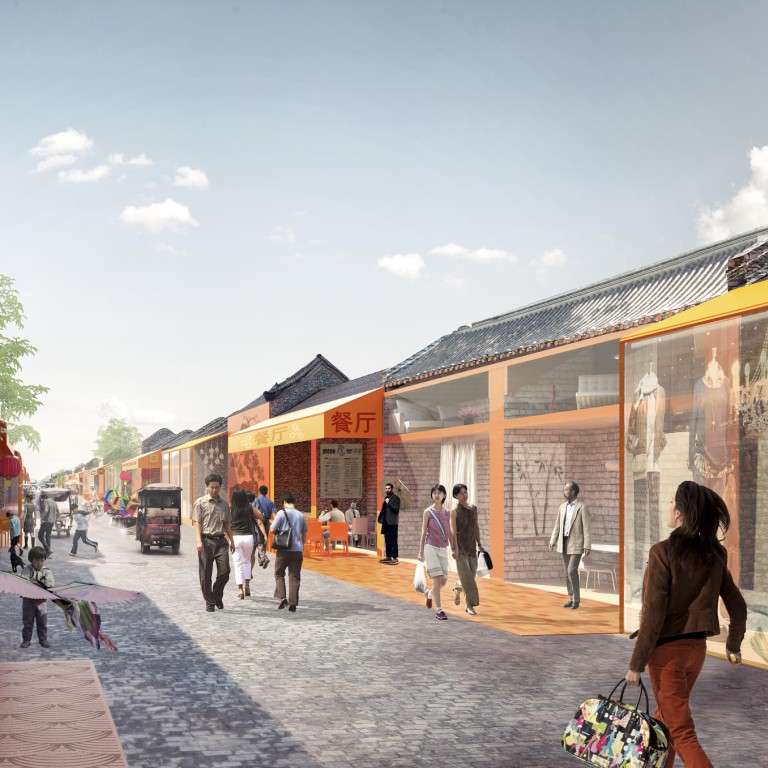
Beijing's old hutong alleyways offer vision of a better future society for Dutch architect in Shanghai
Shanghai-based Marta Pozo says urban planners can learn from capital's archaic alleyways, which encourage interaction and strengthen community spirit
The beauty of old Beijing hutongs (or laneways) is not only in their peculiar architecture, which has defined the capital since ancient times, but also in what they have done for society, says Marta Pozo, a Dutch architect stationed in Shanghai.
Pozo moved from Rotterdam to take up the reins as director of MVRDV Asia in 2014, two years after the Dutch-based architecture firm opened a China office as a base for its growing portfolio of local projects.
And while the company's work runs the gamut from large-scale master planning to commercial, mixed-use, cultural, residential and interior-design commissions, it is the intimate way the Chinese have traditionally lived that truly sparks Pozo's imagination.
This led MVRDV to create two exhibitions related to a new model of redevelopment for traditional hutongs: the Next Hutong for the Xianyukou hutong and the Collective Hutong for Dashilar hutong, both key heritage zones in Beijing listed for protection by the central government.
These gentrified alleys have become a cultural symbol of old Beijing, updated with new public infrastructure facilities, and MVRDV's aim with the exhibitions is to carry that vision forward for future generations.
The Next Hutong was first exhibited in 2014 at the Beijing Centre of the Arts. Last month, it was presented as part of the Nurturing House, the Dutch component of Beijing Design Week 2015.
The Nurturing House, which will be on display until October 30, showcases ideas for a sustainable future in China, and how cities globally can be happier and healthier in the urban age.
The Next Hutong explores the development of the Xianyukou hutong through film and a large-format book. Progress on the Xianyukou precinct has been delayed longer than in surrounding areas, which "creates an enormous potential for the area", Pozo says.
The idea is to "create a hutong that is at once monumental, dense, green, mixed and individual", according to Pozo.
She says the exhibition embodies innovation and creativity for a better urban future, while also demonstrating the spirit and strengths of Dutch design: open-minded, conceptual, contextualised and adhering to the principle "less is more". The strategy is for redevelopment of the hutongs rather than a master plan for a brand new design, she adds.
The Collective Hutong develops MVRDV's ideas about spatial interventions in Beijing's hutongs by creating a public space with - surprisingly - a collection of brightly coloured foam furniture at its core.
Pozo explains that the aim of the furniture - also designed by MVRDV - is to provide functional but sculptural pieces that residents of the hutong can interact with, and that will encourage them to gather in a pleasant community meeting place.
It was exhibited as one of the pilot projects proposed this year for the Dashilar neighbourhood, which has become a testing ground for innovative urban-living ideas.
It joins concepts such as last year's Humble Hostel, a 12 square metre living space that has since progressed to construction of a prototype, and the experimental Plug In Courtyard, also launched in 2014. It also moved to the next phase at this year's Design Week and is now pending a patent.
Pozo's fascination for the hutongs stems from her understanding of their relevance to Chinese history, and the strong identity they bring to a city.
The hutongs and their courtyard houses were the fabric of Chinese society, Pozo says. Through architecture that enabled neighbourly interaction, the quality of the community and its social ties was strengthened.
"You cannot freeze hutongs - just as you cannot freeze history. But architects can and should link to the past in order to project a brighter future," she says.
Dutch ambassador Aart Jacobi agrees that much can be gained from matching Chinese and Dutch expertise in collaborative creative partnerships, jointly working towards improving the quality of life in urban cities for the long term.
"It's wonderful to see so many of our country's key innovators taking part in the Next City Living Lab," he says.
"This shows that China is an important partner for the Netherlands in the creative industries," he adds.
MVRDV's two exhibitions are still only in the research phase of what's expected to be a multipart gentrification of two important urban residential precincts in China. But Pozo hopes others will pick up the ball and run with it - including city planners and, crucially, developers who could make such vision a reality.

